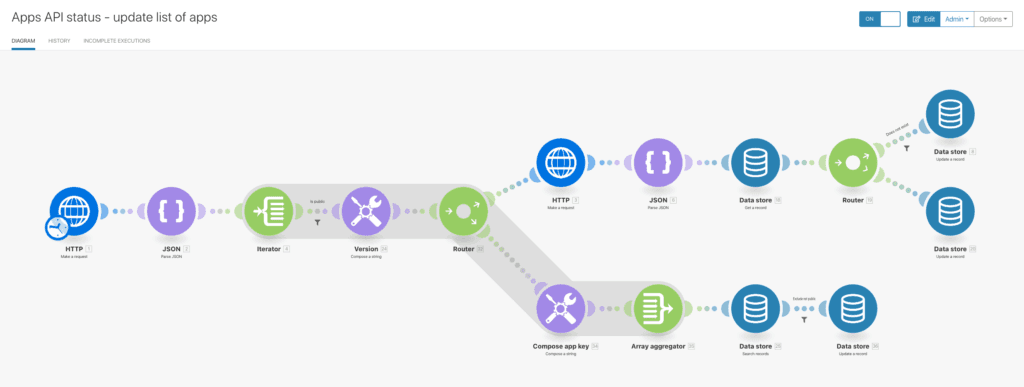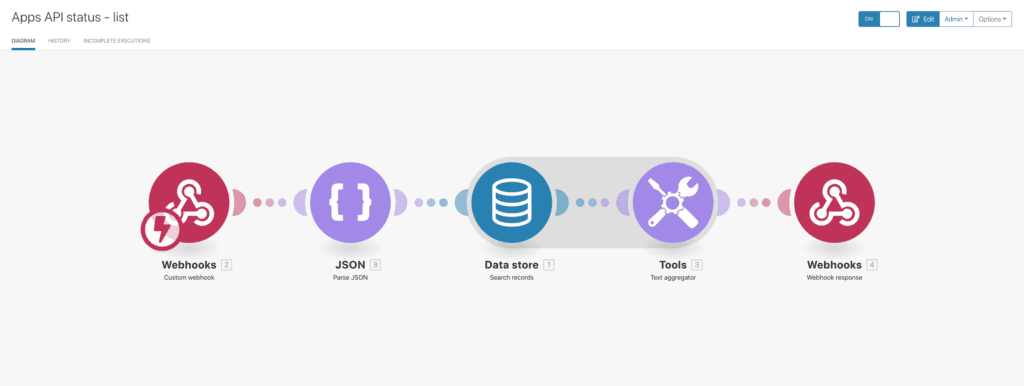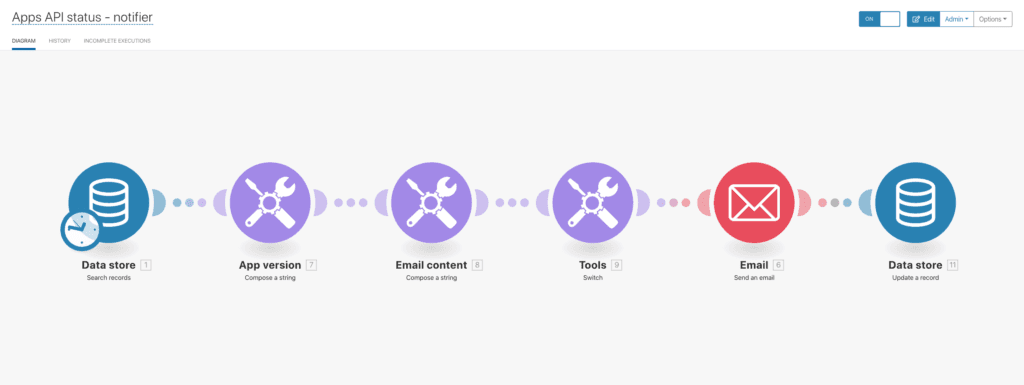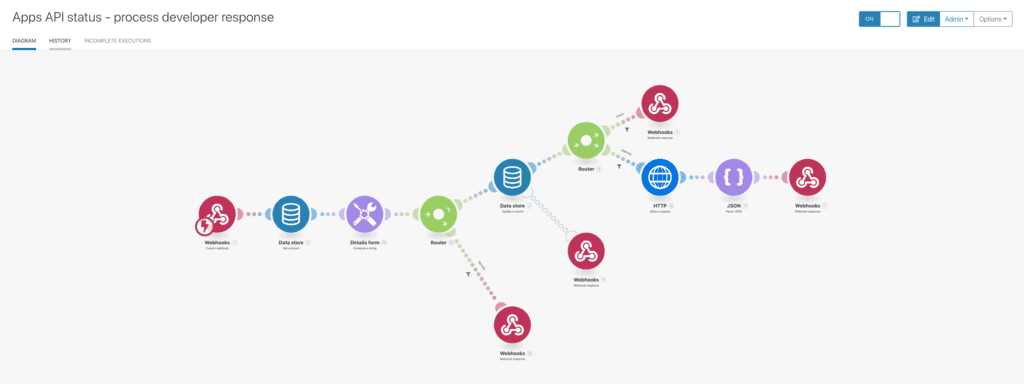Feb 28, 2020 | 6 minutes
How We Eat Our Own Dog Food at Make
Interested in a powerful, versatile product for your cloud-based integration needs? Learn about how we use Integromat at Integromat.

Many expressions have been coined to capture the essence of the singular exercise that is employees using their company’s products; “eating your own dog food” is the one that stuck.
I’ve found myself at odds with the analogy, because most dogs, let’s face it, aren’t picky eaters. My last mutt - may he rest in peace - would chug whatever you gave him. He could eat trash and filet mignon with the same contagious enthusiasm. He loved his dog food, but the problem is that everything was dog food to him.
In other words, I don’t think dogs are a good representation of employees here. But hey, I get it. The image is powerful, and the phrase stuck. It calls for confidence in your own product, like a faith test of sorts.
Also, I’m positive that this whole “eating your dog food” thing is more dramatic and daunting for people working in other industries - say, tobacco industry workers, or that guy who claimed on TV that a famous pesticide was safe to drink and then refused to do so.
In this line, I must tell that if you made it this far expecting that type of cinematic drama, feel free to stop reading. It’s not like that at Make. Using our product is definitely not like jumping through a ring of fire. It’s fun, only not that kind of fun.
On the other hand, if you are interested in learning about a powerful product for your cloud-based integration needs, please bear with me: I’m going to show you how we use Make at Make.
My first Make integration
Make employees are encouraged to use and explore the product but never forced to do so. As long as what we do is legal, we are free to:
Use Make for whatever we want
Think of new use cases for it
Openly discuss potential use cases and ideas
Develop new integrations, scenarios, and templates when feasible
All of this was like a breeze of fresh air, and my early impressions of those first interactions with the product remain unscathed:
Creating an account was easy and fast
The visual canvas instantly felt like a digital playground
Two points for Make. In the following months, I ended up ideating and testing integrations I never thought I would be able to materialize, including:
A cybersecurity automation that notifies me if my email is breached (along with details of the breach)
A newsletter storage system
A series of keyword-watching integrations that help me remain updated on automation-related conversations taking place on Twitter and Reddit
In addition, I’m exploring new concepts, including a feminist bot and a political opinion mapping system that categorizes political inclination by industry/professional sector.
For a Content Strategist that doesn’t know how to code, this is not too bad - but what about more advanced stuff? This, dear reader, is where Make gets really interesting.
The good stuff: Company-wide integrations
The HR and Engineering teams at Make have created many integrations for internal use. Some are particularly useful and elegant, such as:
A notification system that messages contractors via Slack, informing them how many hours they’ve worked at the end of the month, and how much their work amounts for in $ (so they can invoice timely and accordingly)
A communication system that bridges the support and dev teams by watching Zendesk tickets and Github issues
A monitoring system to stay updated with changes to third-party apps and their APIs
The last one is particularly useful.
As a cloud-based integration product featuring hundreds of apps, Make monitors APIs 24/7. Naturally, we automated the whole process using our product, eating our own dog food.
Let’s take a deeper look at how we did it.
Automated app monitoring system
The most important thing we monitor are changes to APIs of the apps Make has integrations with. To be precise, Make modules are updated with the latest API endpoints, and new apps versions are created whenever there is a new API version.
Also, here’s when reality hits. Some services send developer newsletters with all the important news and changes, but most don’t. They simply roll out changes, and everyone else has to either follow the music or fall out of rhythm.
A solution to this problem was vital for us, so our teams stepped in. The whole following the music thing? We automated it!
The solution monitors apps on a constant basis and then stores evidence in separate data stores. This way, we know when the app was last checked, and what was the result of the check (and every check before that too).
How does it work? With four scenarios:
First scenario displays app data, allowing us to be updated about the status of apps
Second scenario watches last app checks
Third scenario sends a notification to developers when it is necessary to check the status of the app
Fourth scenario processes developer response using a form generated via webhook
This is what the scenarios look like:
API status checker
Our API checker. This scenario gets lists of apps from Make and sends them to data stores.
API status lister
Second scenario. This one generates a webpage with a list of apps and its corresponding statuses from the data store.
API status notifier
Third scenario. This cutie sends emails to developers when the case calls for it.
Developer response processor
Fourth and final scenario. It empowers developers with an efficient feedback system. It’s a very efficient first-response system for API-related situations.
As you can imagine, this is just a sample of how we eat our own dog food at Make. There are many other things we’re using our product for, but I’ll leave those for another occasion.
Takeaway
Eating our own dog food is not new to us. We've been doing it since the company was formally established, and before that too.
Surprisingly enough, we keep finding new ways to use our product internally every other week. For us, Make is the gift that keeps on giving, and we are here to share it with the world.
Companies are in dire need of workflow automation solutions for many reasons, notably:
To develop new custom apps in a fast, efficient fashion
To drastically raise productivity levels
To improve employee motivation
To reduce IT-related costs
And there’s no reason to miss out. We have a powerful product that we use and love, and we are not afraid to show it. As the late salesman and storyteller Zig Ziglar once said:
If you believe your product or service can fulfill a true need, it’s your moral obligation to sell it.
Make fills not one true need, but many. It is how you unclog your internal app development pipeline, and also how you expand your company's IT capabilities without breaking the budget.
It is workflow automation that actually works.
Be more than you can be
There's a story I always remember when thinking of our product.
A couple of years ago, I was sitting at a cafe with a coder acquaintance of mine, and I asked him how long would it take me to reach his level if I ever decided to jump into programming from scratch.
He smiled wryly and answered that it would probably take me 8 to 10 years to get there. I remained silent for a couple of seconds and changed the topic, but never forgot that smile.
Fast forward to a couple of months ago. I'm having dinner at a friend's house, and the programmer is there. We haven't seen each other for a long time.
At one point, we are discussing Twitter, and I mention how easy it has become to follow topics by creating custom hashtag trackers. Before I could end the sentence, he stopped me to extend his congratulations.
"You finally learned how to code!", he said.
I gave him an honest smile. "No, I actually didn't", I said. "I just use Make".
He stared back in confusion. I changed the topic shortly after but, once again, I couldn't forget the expression in his face. It made me feel reassured.
We are building a wonderful product. We are part of a wonderful community of makers. The possibilities feel endless, and you are just a couple of clicks away from being part of it all.
Happy automating!
Ready to make the automation revolution happen?





